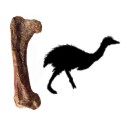
|
A femur of the Late Cretaceous giant bird Gargantuavis from Cruzy (southern France) and its systematic implications
Keywords:
Aves; femur; France; Gargantuavis; Late Cretaceous
doi: 10.18563/pv.42.1.e3
Cite this article:
Buffetaut E., Angst D., 2019.
A femur of the Late Cretaceous giant bird Gargantuavis from Cruzy (southern France) and its systematic implications
. Palaeovertebrata 42(1)-e3. doi: 10.18563/pv.42.1.e3
Export citation
Abstract
A large avian femur recently discovered at the Late Cretaceous Montplo-Nord locality at Cruzy (Hérault, southern France) is referred to the giant bird Gargantuavis philoinos. The estimated mass of the bird is 57 kg, within the range of living cassowaries. The specimen provides new evidence about the anatomy of G. philoinos, notably showing that the distal end of the femur was similar to that of modern birds in having a condylus lateralis subdivided into two semicondyles. A new diagnosis of Gargantuavis philoinos is provided and the taxon is placed in a new family of basal ornithurines.
Published in Vol 42-1 (2019)
Bibliography
Anderson, J.F., Hall-Martin, A. & Russell, D.A. 1985. Long-bone circumference and weight in mammals, birds and dinosaurs. Journal of Zoology A207, 53-61. https://doi.org/10.1111/j.1469-7998.1985.tb04915.x
Angst, D. & Buffetaut, E. 2017. Paleobiology of giant flightless birds. London & Oxford, ISTE Press & Elsevier.
Angst, D., Buffetaut, E., Corral, J.C. & Pereda-Suberbiola, X. 2017. First record of the Late Cretaceous giant bird Gargantuavis philoinos from the Iberian Peninsula. Annales de Paléontologie 103, 135-139 https://doi.org/10.1016/j.annpal.2017.01.003
Baumel, J. J. & Witmer, L. M. 1993. Osteologia. In J. J. Baumel, J. E. Breazile, H. E. Evans, J. C. Vanden Berge (Eds), Handbook of Avian Anatomy: Nomina Anatomica Avium 2nd ed. (eds), pp. 45-132. Cambridge, Massachussetts, Nuttall Ornithological Club.
Bell, A.K. & Chiappe, L.M. 2016. A species-level phylogeny of the Cretaceous Hesperornithiformes (Aves: Ornithuromorpha): implications for body size evolution amongst the earliest diving birds. Journal of Systematic Palaeontology, https://doi.org/10.1080/14772019.2015.1036141
Bell, A.K., Chiappe, L.M., Erickson, G.M., Suzuki, S., Watabe, M., Barsbold, R. & Tsogtbaatar, K. 2010. Description and ecologic analysis of Hollanda luceria, a Late Cretaceous bird from the Gobi Desert (Mongolia). Cretaceous Research 31, 16-26. https://doi.org/10.1016/j.cretres.2009.09.001
Buffetaut, E. & Angst, D. 2013. New evidence of a giant bird from the Late Cretaceous of France. Geological Magazine 150, 173-176. https://doi.org/10.1017/S001675681200043X
Buffetaut, E. & Angst, D. 2016a. The giant flightless bird Gargantuavis philoinos from the Late Cretaceous of southwestern Europe: a review. New Mexico Museum of Natural History and Science Bulletin 71, 41-50. https://doi.org/10.18563/pv.39.2.e3
Buffetaut, E. & Angst, D. 2016b. Pelvic elements of the giant bird Gargantuavis from the Upper Cretaceous of Cruzy (southern France), with remarks on pneumatisation. Cretaceous Research 66, 1-6. https://doi.org/10.1016/j.cretres.2016.06.010
Buffetaut, E. & Le Loeuff, J. 1998. A new giant ground bird from the Upper Cretaceous of southern France. Journal of the Geological Society, London 155, 1-4. https://doi.org/10.1144/gsjgs.155.1.0001
Buffetaut, E., Angst, D., Mechin, P. & Mechin-Salessy, A. 2015. New remains of the giant bird Gargantuavis philoinos from the Late Cretaceous of Provence (south-eastern France). Palaeovertebrata 39, 1-6. https://doi.org/10.18563/pv.39.2.e3
Campbell, K.E. & Marcus, L. 1992. The relationship of hindlimb bone dimensions to body weight in birds. Natural History Museum of Los Angeles County Science Series 36, 395-412.
Chiappe, L.M. 1996. Late Cretaceous birds of South America: anatomy and systematics of Enantiornithes and Patagopteryx deferrariisi. Münchner Geowissenschaftliche Abhandlungen A30, 203-244.
Chiappe, L.M. 2002. Osteology of the flightless Patagopteryx deferrariisi from the Late Cretaceous of Patagonia (Argentina). In L. M. Chiappe, L. M. Witmer (Eds), Mesozoic Birds. University of California Press, Berkeley, pp. 281-316.
Chiappe, L. M. & Walker, C.A. 2002. Skeletal morphology and systematics of the Cretaceous Euenantiornithes (Ornithothoraces: Enantiornithes); in L. M. Chiappe, L.M. Witmer (Eds.), Mesozoic Birds: Above the Heads of Dinosaurs. University of California Press, Berkeley, pp. 240-267.
Chinsamy, A., Buffetaut, E., Canoville, A. & Angst, D. 2014, Insight into the growth dynamics and systematic affinities of the Late Cretaceous Gargantuavis from bone microstructure. Naturwissenschaften 101, 447-452. https://doi.org/10.1007/s00114-014-1170-6
Clarke, J. 2004. Morphology, phylogenetic taxonomy, and systematics of Ichthyornis and Apatornis (Avialae: Ornithurae). Bulletin of the American Museum of Natural History 286, 1-179. https://doi.org/10.1206/0003-0090(2004)286<0001:MPTASO>2.0.CO;2
Dunning, J.B. 2008. CRC Handbook of avian body masses, 2nd edition. Boca Raton, CRC Press. Elzanowski, A. 2008. The avian femur: morphology and terminology of the lateral condyle. Oryctos, 7, 1-5.
Haeckel, E. 1866. Generelle Morphologie der Organismen, Band 2. Berlin, Georg Reimer. https://doi.org/10.1515/9783110848281
Linnaeus, C. 1758. Systema naturae. Stockholm, Laurentius Salvius.
Marsh, O. C. 1880. Odontornithes: A Monograph of the Extinct Toothed Birds of North America. Washington, Government Printing Office. https://doi.org/10.5962/bhl.title.61298
Mayr, G. 2017. Avian evolution. The fossil record of birds and its paleobiological significance. Chichester, Wiley Blackwell.
https://doi.org/10.1002/9781119020677
O'Connor, P.M. 2009. Evolution of archosaurian body plans: skeletal adaptations of an air‐sac based breathing apparatus in birds and other archosaurs. Journal of Experimental Zoology A311, 629-646. https://doi.org/10.1002/jez.548
O'Connor, P.M. & Forster, C.A. 2010. A Late Cretaceous (Maastrichtian) avifauna from the Maevarano Formation, Madagascar. Journal of Vertebrate Paleontology 30, 1178-1201. https://doi.org/10.1080/02724634.2010.483544
Walker, C. A. & Dyke, G. 2009. Enantiornithine birds from the Late Cretaceous of El Brete (Argentina). Irish Journal of Earth Sciences 27, 15-62. https://doi.org/10.3318/IJES.2010.27.15
Worthy, T.H. 1988. An illustrated key to the main leg bones of moas (Aves- Dinornithiformes). National Museum of New Zealand Miscellaneous Series 17, 1-36.
Zinoviev, A.V. 2010. Comparative anatomy, structural modifications and adaptive evolution of avian apparatus of bipedal locomotion. Moscow, KMK Scientific Press (in Russian).
|
PDF |
|
